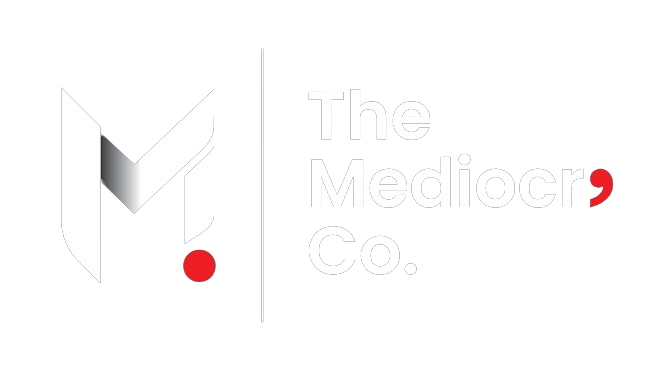How To Write Website Content: The Ultimate Guide!
Are you new to writing website content? Maybe you are a freelance writer or a website content writer. Or perhaps you are a small business owner who wants to save money by writing your own effective website content writing instead of hiring a professional content writer. No matter who you are, we are here to help you. After reading this guide from The Mediocre Co., creating or optimizing website content will be easier for you.
The Mediocre Co. has your back. Grab a cozy seat, and a steaming mug of chai, and get ready to embark on a delightfully irreverent journey through optimizing website content. We promise you’ll get the answer to how to write content for a website.
Website Content Writing Tips: Top 8 Rules to Follow and Mistakes to Avoid
#1 Website Content Writing Tip: Know Your Target Audience (Or Risk Missing the Mark)
 One of the top website content writing tips is to truly understand your target audience. Can you imagine someone writing a blog post about denture adhesives for a teenage audience – it’s likely to have them clicking away faster than you can say “Hullaballoo.”
One of the top website content writing tips is to truly understand your target audience. Can you imagine someone writing a blog post about denture adhesives for a teenage audience – it’s likely to have them clicking away faster than you can say “Hullaballoo.”
Great Website content writing strategies include tailoring your content to resonate with your intended readers is crucial. For example, if you’re creating content for an adventure travel website, you’ll want to use exciting language that captures the thrill-seeking spirit instead of dry, uninspiring descriptions.
One of the website content writing best practices is to study your audience’s interests, language, and pain points. Are they fitness enthusiasts? Use relatable gym lingo and offer solutions to their workout challenges. Are they tech professionals? Embrace industry terminology and showcase your expertise with references to current trends.
Writing for a generic, one-size-fits-all audience is like serving up a bland meal – it won’t leave a lasting impression. By truly understanding your target audience, you’ll be able to create website content that speaks directly to them, fostering a connection that keeps them engaged and coming back for more.
Take our website for example, we know that our audience would love CTAs that are not cliched such as “Contact Us”, we have created website content for The Mediocre Co. that resonates with our services and our work, crazy and desperate (just like you on valentines day).
#2 Website Content Writing Tip: Have a Clear Purpose (Why Are We Here? Just to Suffer)
In this website copywriting guide, one of the cardinal rules is to have a clear purpose for your content. Diving headfirst into writing without a well-defined objective is like setting off on a road trip without a destination or a map – you’ll end up meandering aimlessly, running in circles, and quite possibly losing your sanity along the way.
Before you even put pen to paper (or finger to keyboard, as the case may be), read this blog of website content writing tips and ask yourself: “What am I trying to achieve with this piece of website content?” Are you aiming to educate your audience about a particular product or service? Nudge them towards making a purchase? Establish your brand as a thought leader in your industry? Whatever the goal may be for effective website content writing, keep it front and center throughout the writing process.
This Website content writing guide focuses on having a clear purpose that will not only give your content a cohesive, focused structure but will also infuse it with a sense of direction and intentionality. Without it, you risk veering off into tangential territory, leaving your readers scratching their heads in bewilderment – and quite possibly seeking solace in more purposeful pursuits, like watching the modern-day cartoon networks
Take us for example (yes again, we’ll keep on talking about us). When we started this little venture of Professional website content writing (formerly known as ByDevumm, because apparently, we love confusing people with name changes) our grand plan was simple:
- Become the go-to source for all things Ahmedabad. After all, we’re proud Amdavadis, and who better to dish out the inside scoop on our beloved city?
- We quickly realized that finding unlimited food and unique cafes in Ahmedabad was harder than getting a rickshaw driver to use the meter. Why? Because we were tired of aimlessly wandering the streets, hangry and confused, in search of the perfect spot to stuff our faces. Web content writing best practices be damned, we needed sustenance!
- Being the control freaks that we are, we craved a space where we could bring out our creativity without anyone telling us that our puns were too cheesy or our grammar was more questionable than our fashion choices. Website content creation was our ticket to freedom!
- Finally, we figured we might as well jump on drafting SEO content and create some blogs that would make Google’s algorithm go gaga. I mean, who doesn’t want to read a riveting piece on the differences between a copywriter and a content writer? (Spoiler alert: one of them is better at crafting bad jokes.)
So, as you walk through the journey of optimizing website content or tackling that next how-to-write-for websites project, take a moment to map out your purpose for writing compelling website content. Trust us; your readers (and your own sanity) will thank you for it.
#3 Website Content Writing Tip: Optimize for Search Engines (The Art of Selling Your Soul to Google)
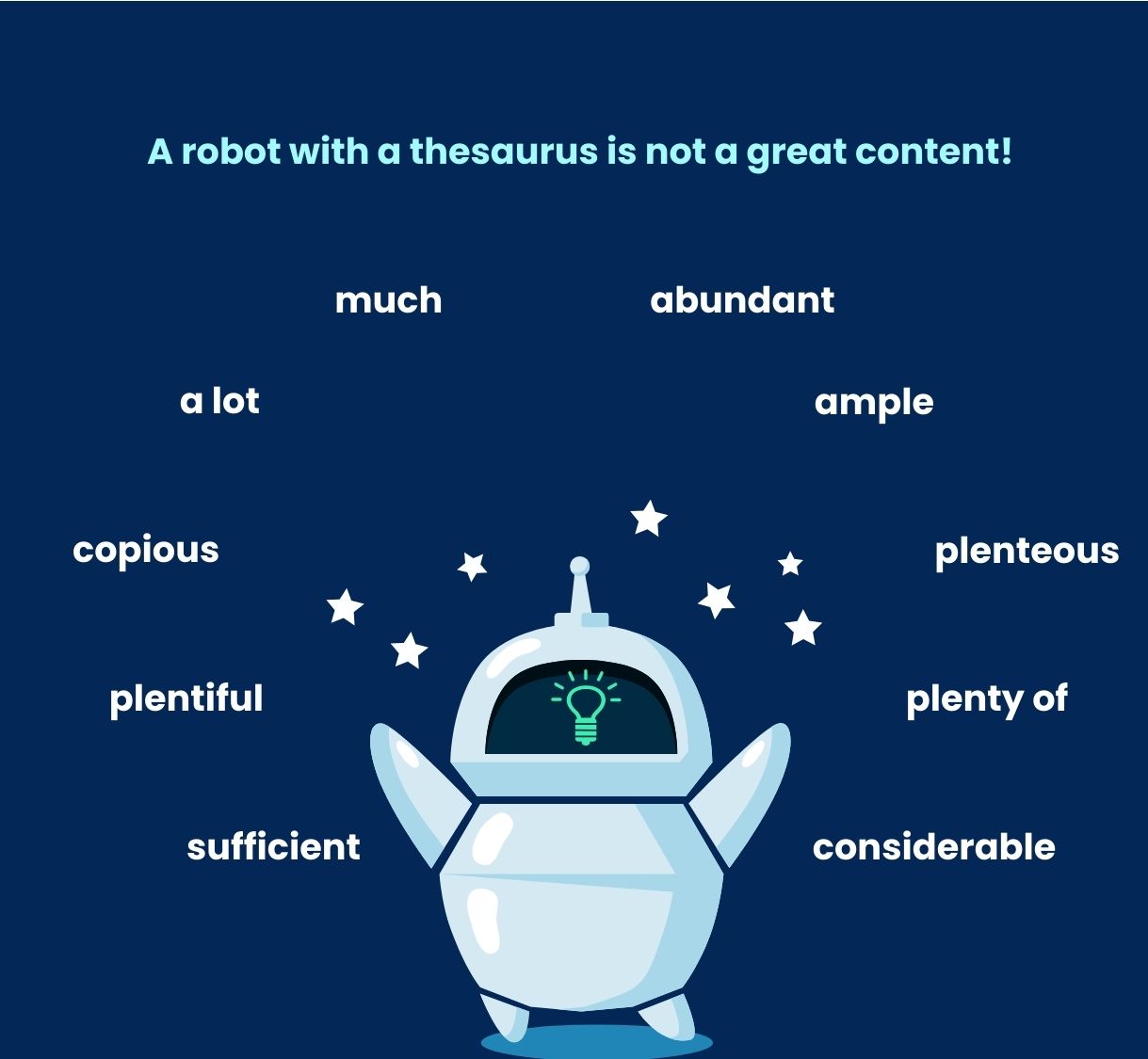 For this website copywriting guide, let’s talk about optimizing your content for search engines. I know, I know, it sounds about as exciting as watching Morbius in theater, but hear me out. Stuffing your content with keywords like “website content writing tips”, “how to write content for website”, and “web content writing best practices” can actually do wonders for your site’s visibility (these keywords were here for us).
For this website copywriting guide, let’s talk about optimizing your content for search engines. I know, I know, it sounds about as exciting as watching Morbius in theater, but hear me out. Stuffing your content with keywords like “website content writing tips”, “how to write content for website”, and “web content writing best practices” can actually do wonders for your site’s visibility (these keywords were here for us).
But don’t go overboard, or you’ll end up sounding like a robot with a thesaurus. Now, let’s talk money. If you’re looking to outsource your content creation, be prepared to shell out some serious rupees or dollars (we accept whatever you’re offering). Website content writing rates in India can vary wildly, from a measly 10 paise per word to a whopping 5 rupees!
Enters The Mediocre Co., we are the most awesome content writers in India you can get and we are the best bang for your buck. Our website content writing rates are not bottom-of-the-barrel nor are they like the stars in the sky, our website content writing rates are like regular joe, not heavy on your purse and we give you good enough website content to make your life a little bit happier.
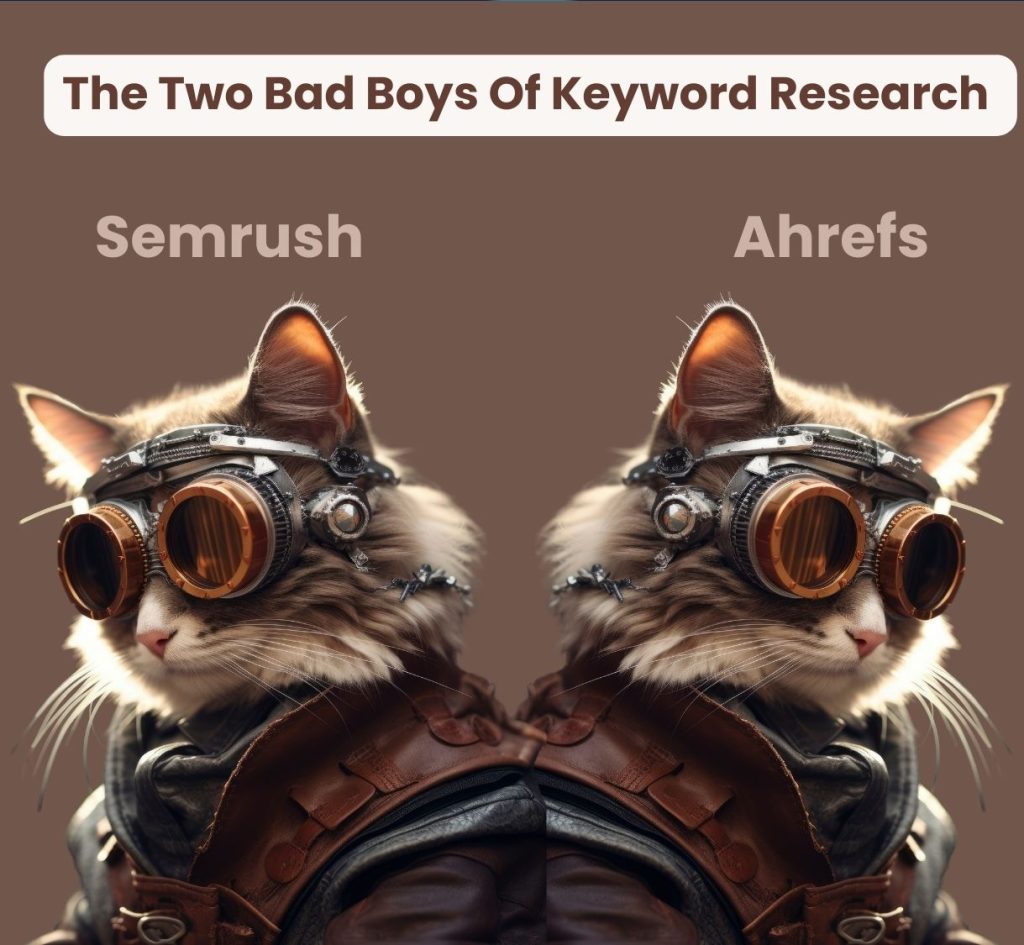 Website content creation is an art and to figure out what keywords to use, you’ll want to use some SEO Keyword research tools like Semrush or Ahrefs. These bad boys will tell you what keywords people are searching for, how often they’re searching for them, and how competitive they are.
Website content creation is an art and to figure out what keywords to use, you’ll want to use some SEO Keyword research tools like Semrush or Ahrefs. These bad boys will tell you what keywords people are searching for, how often they’re searching for them, and how competitive they are.
Once you’ve got your keywords, it’s time to sprinkle them throughout your content like the dandruff in your head (ok, a little less than that) to make it engaging website content. But don’t go overboard – you don’t want to sound like a robot. Use them naturally, like you’re having a conversation with your readers.
Remember, at the end of the day, you’re optimizing website content for humans, not robots. So don’t sacrifice readability and quality for the sake of cramming in keywords. Find that sweet spot where your website content is both optimized and enjoyable to read.
Here comes the best part of each heading for website content writing tips, our own example. Take this blog for example, we have created a list of keywords to sprinkle throughout the blog, the list of which is:
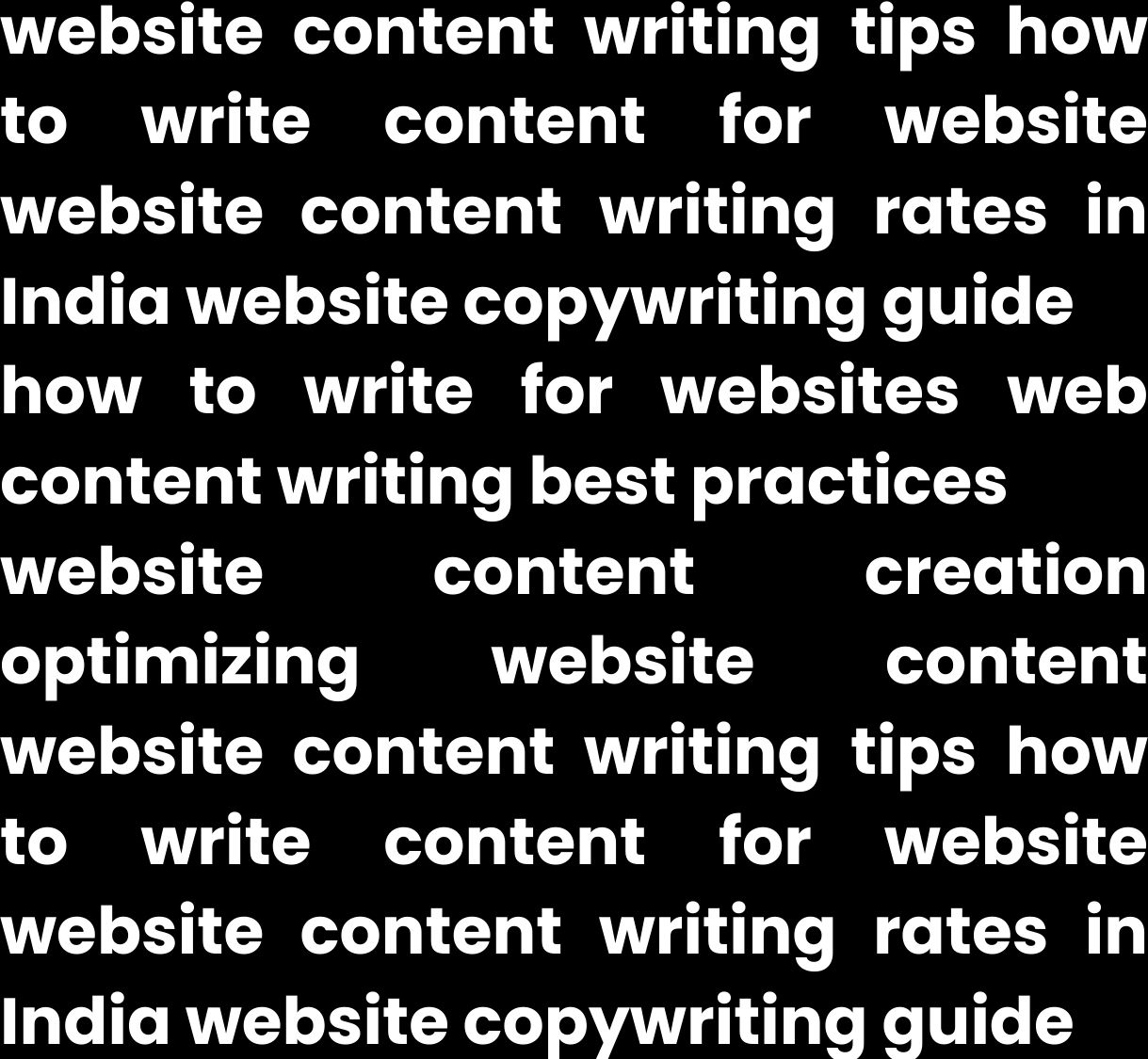
- website content writing tips
- how to write content for website
- website content writing rates in India
- website copywriting guide
- how to write for websites
- web content writing best practices
- website content creation
- optimizing website content
Yes, we are aware of the difference between website content and article content. However, we had a list of keywords for this blog, so we inserted them here to help you understand.
#4 Website Content Writing Tip: Add Headings and Subheadings (Because You Can’t Expect Everyone to Decipher Your Rambling)
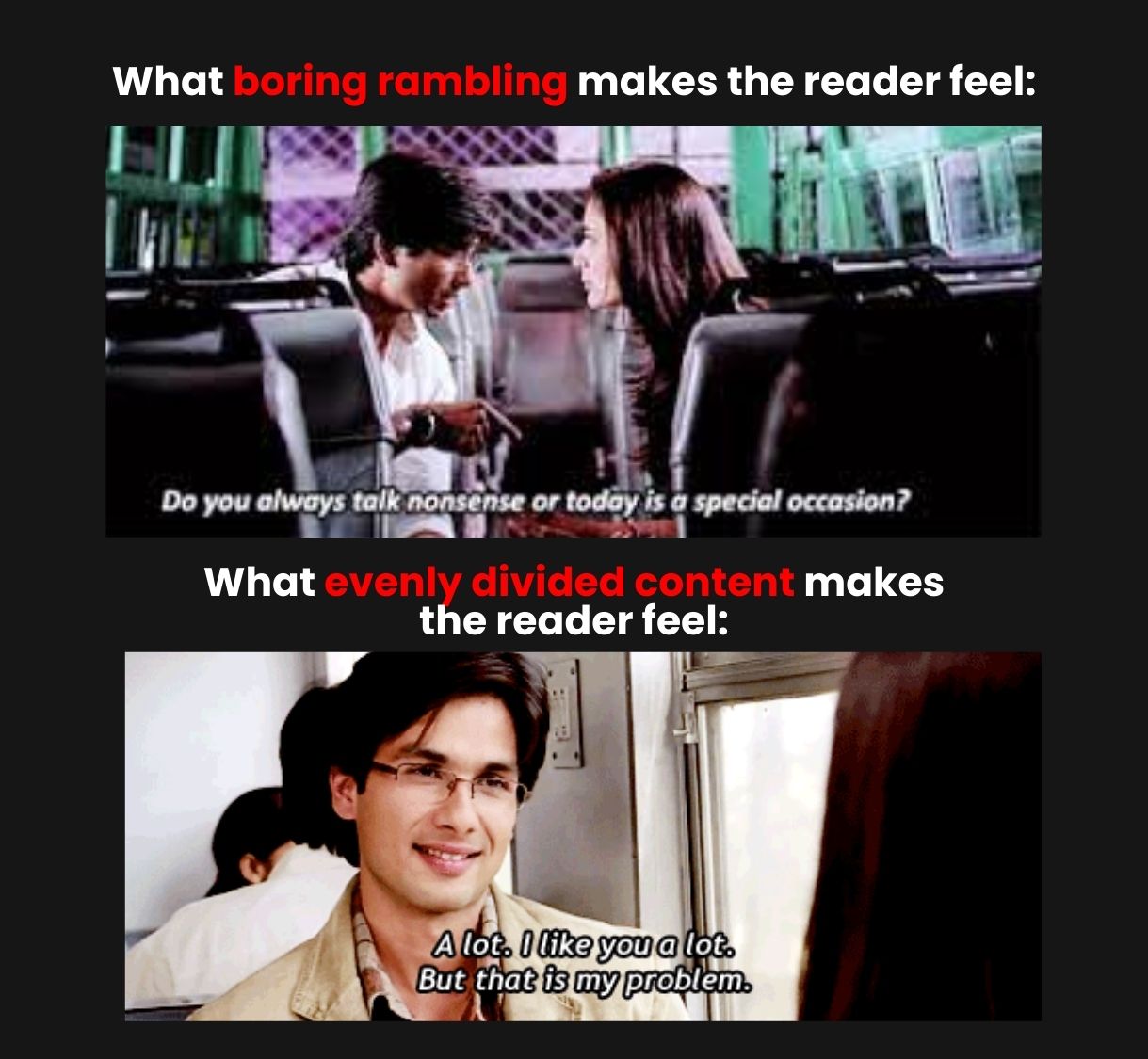 Here’s the thing – most people don’t actually read every single word on a webpage. They scan, looking for the information that’s most relevant to them. By breaking up your content with clear, descriptive headings and subheadings, you make it much easier for readers to find what they’re looking for quickly.
Here’s the thing – most people don’t actually read every single word on a webpage. They scan, looking for the information that’s most relevant to them. By breaking up your content with clear, descriptive headings and subheadings, you make it much easier for readers to find what they’re looking for quickly.
Think of headings and subheadings like signposts guiding your readers through your brilliant prose. Without them, it’s all too easy for visitors to get lost in a wall of text and give up in frustration. And we definitely don’t want that, do we?
So as you’re crafting that killer website content, remember to:
- Use heading tags (H1, H2, H3, etc.) to create a clear content hierarchy
- Make sure your headings are descriptive and contain relevant keywords
- Keep headings concise – no need to write a novel in the subheading
- Use headings to break up content into manageable, scannable chunks
I know, I know – it can be tempting to get creative with your headings and come up with something super clever or funny. But when it comes to website content writing, clarity trumps cleverness every time. Save the puns for your stand-up comedy routine and stick to headings that clearly communicate what each section is about (I know, the irony!).
The best part? Using headings and subheadings isn’t just good for your readers – it’s good for SEO too. Search engines use headings to understand the structure and topic of your content, so strategic use of keywords in your headings can give your content a nice little boost in search rankings.
#5 Website Content Writing Tip: Keep It Concise (Why Say in a Paragraph What You Can in a Sentence?)
We understand that you love your products/services, and we do too, we love this craft. But as we are moving towards everything shorter than it used to be(no double entendre), the attention spans of humans are getting shorter than a goldfish of a mere 8 seconds, so rambling will get you nowhere.
For following website content writing best practices put yourself in your readers’ shoes. They’re busy, they’re distracted, and they’re probably on their office desk ignoring their work, skimming your site. Focus on what’s absolutely essential for them to know and ruthlessly edit out the rest. Your high school teacher might have demanded 5 paragraph essays, but on the internet, short crispy website content is your BFF.
Advice for the website copywriting guide is to steer clear of imploding on industry jargon. You want to sound human. Crisp, clear language is the game for web writing.
Break up your text with plenty of headings, bullet points, and short paragraphs. Big intimidating walls of text send readers running for the hills (or more likely, the back button). Make your content scannable and easy on the eyes.
The truth is, that writing concise website copy is harder than it looks. It takes skill to distill complex ideas down to their essence. But hey, that’s why they pay me the big bucks! (Just kidding, I work for peanuts. The freelance life is rough, y’all).
The bottom line? Treat your website visitors’ time and attention like the precious commodities they are. Give them content that’s tight, bright, and easy to digest. Your readers (and your conversion rates) will thank you.
#6 Website Content Writing Tip: Use Visuals (Break Up Your Text with Visuals, Because Attention Spans Are… Oh Look, a Squirrel!)
 Want to know a secret to making your content pop? Use visuals! I know, I know, you’re probably thinking “But I’m a writer, not a Graphic Designer!” Trust me, you don’t need to be the next M. F. Husain to incorporate some eye-catching visuals into your website content.
Want to know a secret to making your content pop? Use visuals! I know, I know, you’re probably thinking “But I’m a writer, not a Graphic Designer!” Trust me, you don’t need to be the next M. F. Husain to incorporate some eye-catching visuals into your website content.
Here are a few tips on how to use visuals to take your website content from bland to grand:
 Break up walls of text with relevant images. Nobody wants to read a giant block of text. Adding a relevant image every few paragraphs gives readers’ eyes a break and helps illustrate your points.
Break up walls of text with relevant images. Nobody wants to read a giant block of text. Adding a relevant image every few paragraphs gives readers’ eyes a break and helps illustrate your points.
If you’re wondering how to write content for a website that’s both informative and visually appealing, infographics are your answer! Use infographics to present data or complex topics. They can take boring stats or complicated concepts and make them engaging and easy to understand.
Embed videos to add a multimedia element
Videos are a great way to add some variety to your content and appeal to different learning styles. Just make sure to follow this solid website copywriting guide to ensure your videos align with your overall content strategy.
Create custom graphics or GIFs: Custom visuals add personality and help your brand stand out. Don’t be afraid to get a little cheeky with your graphics – a well-placed meme can do wonders! This is one of the more advanced tips on website content, but it can make a big impact.
 Optimize your images for the web: Make sure your visuals aren’t slowing down your page load times by optimizing them for the web. Use descriptive file names and alt text for bonus SEO points! This is a crucial aspect of optimizing website content that often gets overlooked.
Optimize your images for the web: Make sure your visuals aren’t slowing down your page load times by optimizing them for the web. Use descriptive file names and alt text for bonus SEO points! This is a crucial aspect of optimizing website content that often gets overlooked.
The bottom line is, that adding visuals to your website content writing can help make it more engaging. So go forth and visualize! Your readers (and your bounce rate) will thank you. Just remember, when it comes to website content creation, a picture is worth a thousand words…but please, for the love of all things holy, don’t use Comic Sans. Some things are better left in the 90s.
Here is one of the examples of visuals you can use to pop your website content and keep the users engaged: 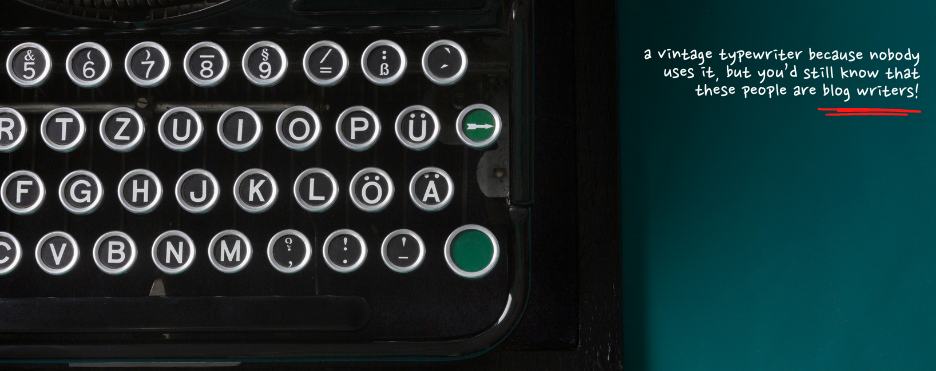
#7 Website Content Writing Tip: Calls-to-Action (The Jedi Mind Trick of Website Content)
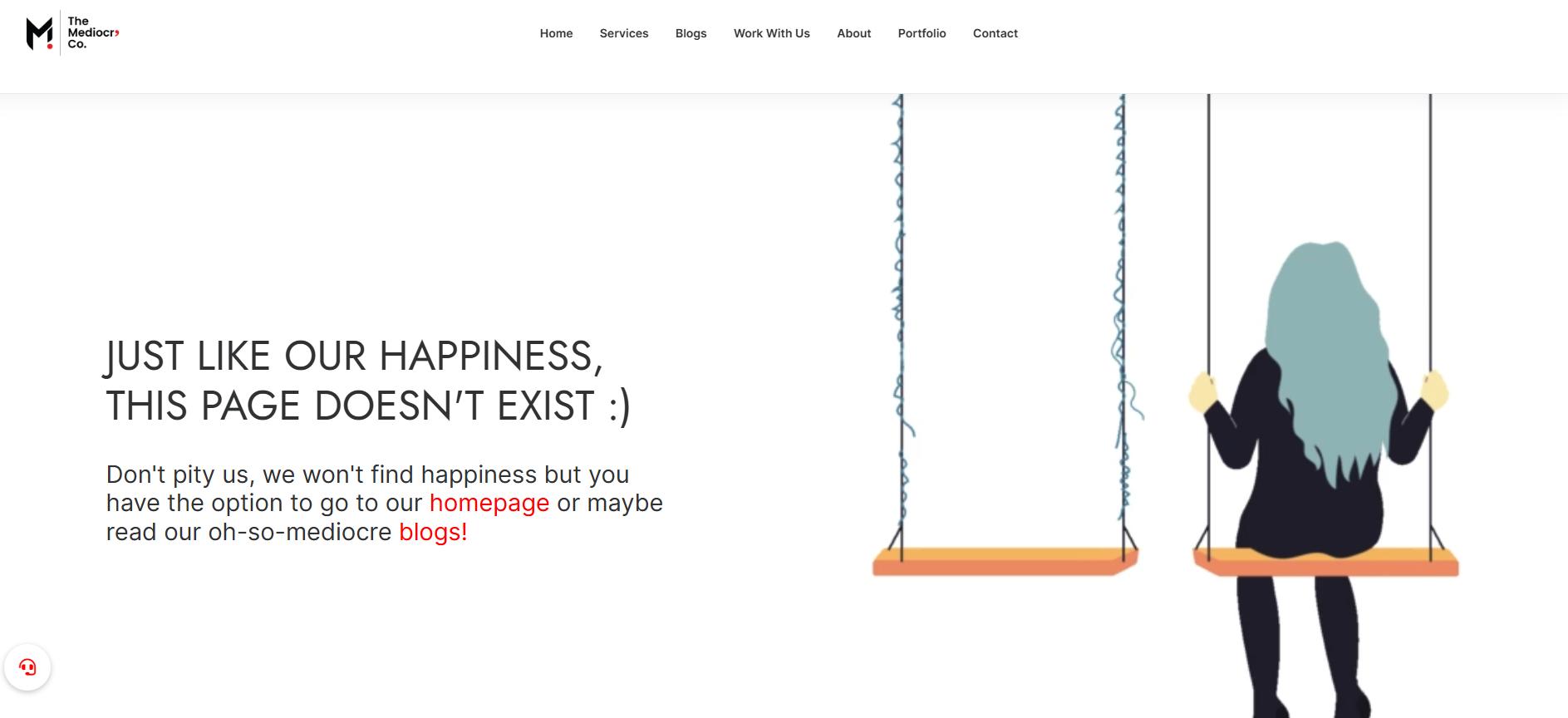 One of the most important aspects of writing for the web: calls-to-action (CTAs). You know, those little nuggets of persuasion that encourage your visitors to take the next step, whether it’s signing up for your newsletter, buying your product, or sharing your mind-blowing content with their friends.
One of the most important aspects of writing for the web: calls-to-action (CTAs). You know, those little nuggets of persuasion that encourage your visitors to take the next step, whether it’s signing up for your newsletter, buying your product, or sharing your mind-blowing content with their friends.
Now, I know what you’re thinking: “But I don’t want to be too pushy!” Trust me, I get it. However, if you want your website to actually achieve its goals, you’ve gotta master the art of the CTA. It’s not about being aggressive; it’s about being clear, concise, and compelling.
So, how do you craft the perfect CTA? Here are a few website content writing tips to keep in mind:
- Be specific: Don’t just say “Click here” or “Submit.” Tell your visitors exactly what you want them to do, like “Sign up for our weekly newsletter” or “Buy now and get 50% off!”
- Create a sense of urgency: Use words like “limited time offer” or “act now” to encourage immediate action.
- Make it visually appealing: Use contrasting colors, bold text, or even eye-catching buttons to make your CTA stand out from the rest of your content.
- Keep it above the fold: Place your CTA in a prominent location, ideally above the fold (the portion of the webpage visible without scrolling), so visitors can’t miss it.
- Test, test, test: Try out different versions of your CTA to see which one performs best. A/B testing is your friend!
- Remember, your website content is only as good as the action it inspires. By following these web content writing best practices and crafting compelling calls-to-action, you’ll be well on your way to turning casual visitors into loyal customers.
So go ahead, get creative with those CTAs! Your website (and your bank account) will thank you.
Not to toot our own horn, but we absolutely, passionately love our CTAs, we did pretty good copywriting for CTAs, take a look and for the love of god don’t plagiarize (give us money and we’ll create something far more superior for you):
#8 Website Content Writing Tip: Proofread and Edit (It’s the Difference Between ‘Let’s Eat Grandma’ and ‘Let’s Eat, Grandma)
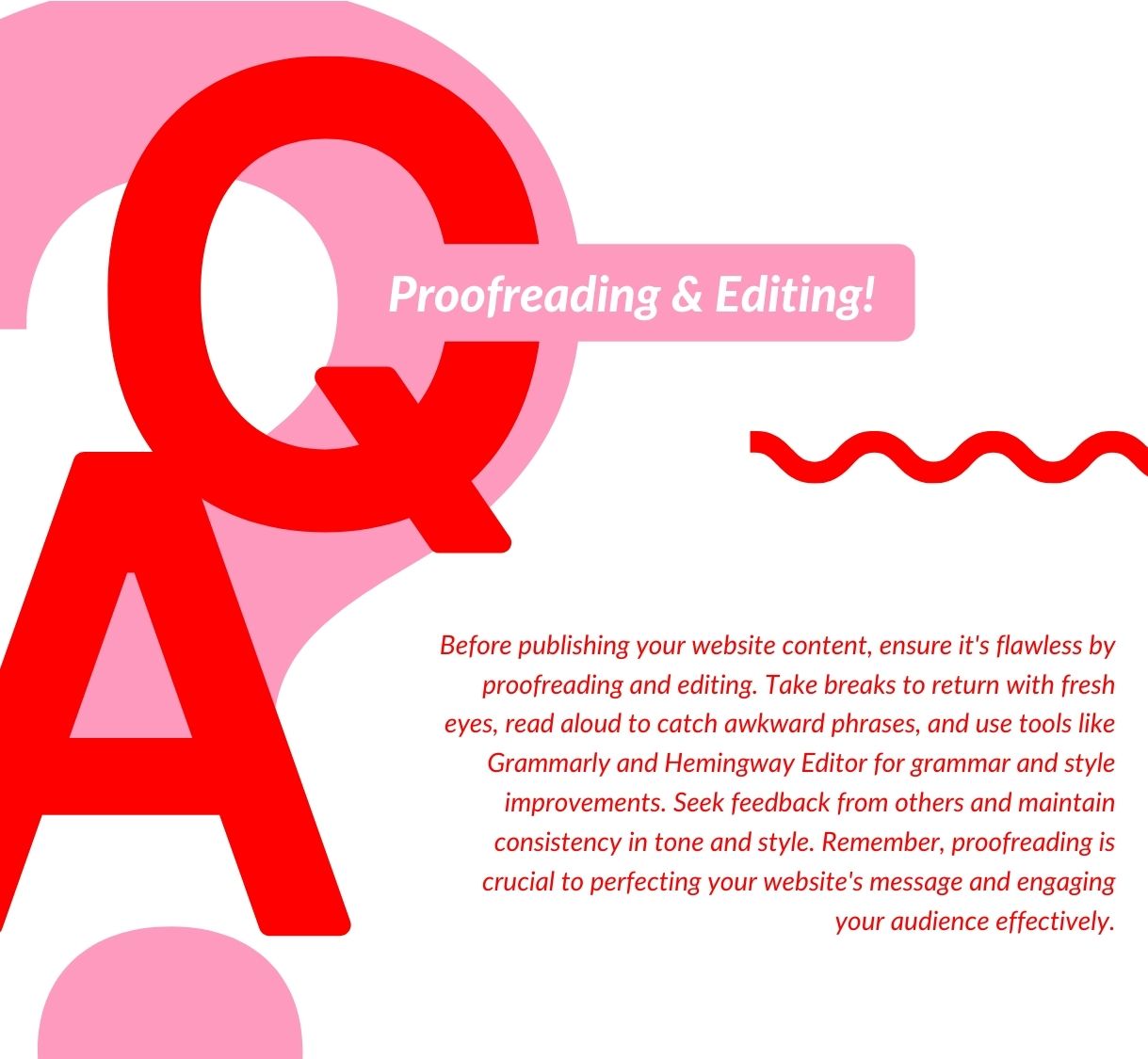 You’ve poured your heart and soul into crafting compelling website content, but hold up! Before you hit that publish button, there’s one crucial step left: Proofreading and Editing. Trust me, even the most seasoned writers make mistakes. It’s like trying to spot your own typos in a text message—nearly impossible without a fresh set of eyes!
You’ve poured your heart and soul into crafting compelling website content, but hold up! Before you hit that publish button, there’s one crucial step left: Proofreading and Editing. Trust me, even the most seasoned writers make mistakes. It’s like trying to spot your own typos in a text message—nearly impossible without a fresh set of eyes!
As you embark on this final phase of website content creation, channel your inner grammar nerd, and let’s dive into some website content writing tips for polishing your content to perfection:
Take a break: Step away from your content for a bit. Go for a walk, grab a snack, or watch Kyunki saas bhi kabhi bahu thi (hey, no judgment here). When you come back with fresh eyes, you’ll be amazed at the errors you catch. This simple tip can make a world of difference in how to write for websites effectively.
Read it out loud: Yes, you might feel a bit silly, but reading your content aloud helps you catch awkward phrasing, run-on sentences, and other issues that might slip by during a silent read. It’s a tried-and-true technique in any website copywriting guide.
Use online tools: Grammarly and Hemingway Editor are some of the most essential tools to help you with website content writing. They’ll help you spot grammar and spelling mistakes, as well as suggest ways to make your writing more concise and readable. These tools are essential for optimizing website content and ensuring your message is clear and engaging.
Get a second opinion: Have a colleague, friend, or even your mom (she’s probably been correcting your grammar since you learned to talk) review your content. A fresh perspective can work wonders and help you identify areas for improvement in your website content creation process.
Check for consistency: Make sure you’re using the same style and tone throughout your content. You don’t want to sound like a PhD thesis on one page and a teenage texting conversation on another. Consistency is key when it comes to how to write content for a website that resonates with your target audience.
Double-check things like links, image alt text, and meta descriptions. These small details can make a big difference in your website’s user experience and SEO. Paying attention to these often-overlooked elements is one of the web content writing best practices that can help you stand out from the competition.
Remember, proofreading and editing are essential parts of the website copywriting process. Don’t let silly mistakes or clunky phrasing distract from your brilliant ideas and carefully crafted website content.
Now, if you’ll excuse me, I need to go proofread this post for the 27th time.
Devam Gala
Devam Gala is the Co-Owner of The Mediocre Co. His mom thinks he's funny (no she doesn't). By day, he writes words that make boring things sound not-so-boring. At night, he sleeps, dreaming of new ways to be delightfully average. His life is nothing too exciting and nothing too disappointing. Just right in the middle - mediocre.

